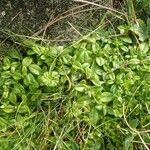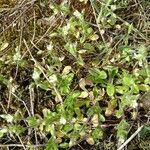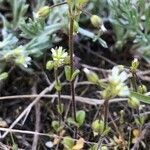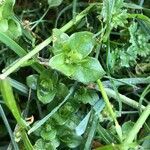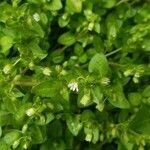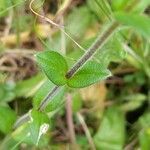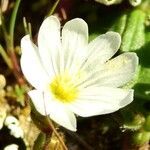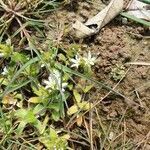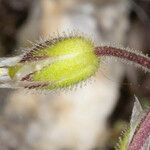Herb, annual (or rarely biennial), with slender tap root, and glandular and eglandular hairs. Stems erect or ascending from leafy rosette, 1–20 cm long. Leaves 2–18 mm long, 1–5 (–7) mm wide; basal leaves petiolate, oblanceolate to elliptic, with petiole to 5 mm long; cauline leaves ovate to broadly ovate-elliptic, sessile. Inflorescence rather lax, few-flowered; bracts with broad to very broad, scarious margins. Flowers (4) 5-merous, 5–7 mm diam.; pedicels to 5 mm long, in fruit longer than capsule, at first deflexed, later erect. Calyx glandular-pilose. Sepals 2.5–5 mm long, ovate, acute, with narrow to broad scarious margins. Petals slightly shorter than sepals (or to 65% of their length), sometimes rudimentary, narrowly obovate, with apices obtuse to acute, emarginate, rarely bifid. Styles 4 or 5. Capsule 3.5–7 mm long, cylindrical, straight to slightly curved. Seeds 0.4–0.5 mm diam., pale yellowish to reddish brown, finely but rather bluntly tuberculate.
Viscid-pubescent annual 0.5–2 dm; lvs relatively small, mostly 0.5–1(1.5) cm, the basal oblanceolate, the cauline ovate to broadly elliptic; infl often compact as in C. viscosum, varying to moderately open and dichasial, the pedicels to a little longer than the sep, usually deflexed in fr; bracts conspicuously scarious-margined and-tipped, the distal portion of the upper ones generally wholly scarious for ca 1 mm or more; sep 3–5 mm, lanceolate, acute, stipitate-glandular, with few or no eglandular hairs, scarious-margined; pet shorter than the sep, only shallowly notched, generally to a depth of less than 0.5 mm; stamens 5 or sometimes 10; capsule 4.5–7 mm, less than twice as long as the sep; seeds smooth or nearly so; 2n=36. Native of Eurasia, now intr. as a weed in much of our range but not so ubiquitous as C. viscosum.
Annual, with all branches reproductive. Stems ascending to erect, sometimes prostrate, (2)-5-15 cm long, with glandular and eglandular hairs. Lvs ovate to oblong to narrow-obovate, (2)-5-10-(20) × (1)-2-5-(10) mm, the lower petiolate, the upper sessile, with eglandular hairs. Infl. ± compact; pedicels usually > sepals at fruiting, with glandular and eglandular hairs. Bracts narrow-ovate with broad scarious margins especially at apex, green part glandular-and eglandular-hairy. Sepals 3-5 mm long, with broad scarious margins especially at apex and glandular and eglandular hairs not overtopping the slightly reflexed apex. Petals < than sepals. Styles 0.5 mm long. Capsule cylindric, slightly curved, up to 11/2× length of calyx. Seeds 0.4 mm long, very finely tuberculate.
An annual herb. It grows up to 20 cm high. It is usually branched from the base. It is slightly sticky to the touch. The leaves are 18 mm long by 2-4 mm wide. They are hairy above. The leaves near the base are broadly sword shaped and the upper ones are more narrow. The flowers are white and 5 mm across. The sepals are longer than the petals. The flowers are loosely arranged.
